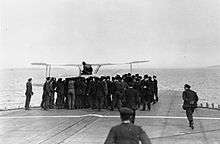Edwin Harris Dunning
| Edwin Harris Dunning | |
|---|---|
 Dunning is congratulated after landing on HMS Furious in his Sopwith Pup on 2 August 1917 | |
| Born |
17 July 1892 South Africa |
| Died |
7 August 1917 (aged 25) Scapa Flow, Orkney |
| Allegiance |
|
| Service/branch | Royal Naval Air Service |
| Years of service | –1917 |
| Rank | Squadron Commander |
| Battles/wars | World War I |
| Awards | Distinguished Service Cross |
Squadron Commander Edwin Harris Dunning, DSC (17 July 1892 – 7 August 1917), of the British Royal Naval Air Service, was the first pilot to land an aircraft on a moving ship.
Early life
Dunning was born in South Africa[1] on 17 July 1892 the second child of Sir Edwin Harris Dunning of Jacques Hall, Bradfield, Essex, he was educated at Royal Naval Colleges at Osborne and Dartmouth.[2]
First landing on a moving ship

Dunning landed his Sopwith Pup on HMS Furious in Scapa Flow, Orkney on 2 August 1917. He was killed five days later, during his second landing attempt of the day, when an updraft caught his port wing, throwing his plane overboard. Knocked unconscious, he drowned in the cockpit.[3]
He is buried at St Lawrence's Church, Bradfield, beside his mother. A plaque in the church states:
The Admiralty wish you to know what great service he performed for the Navy. It was in fact a demonstration of landing an Aeroplane on the deck of a Man-of-War whilst the latter was under way. This had never been done before;and the data obtained was of the utmost value. It will make Aeroplanes indispensable to a fleet;& possibly, revolutionise Naval Warfare. The risk taken by Squadron Commander Dunning needed much courage. He had already made two successful landings;but expressed a wish to land again himself, before other Pilots did so;and in this last run he was killed. My Lords desire to place on record their sense of the loss to the Naval Service of this gallant Officer.
In memory of Dunning, the Dunning Cup or Dunning Memorial Cup is given annually to the officer who is considered to have done most to further aviation in connection with the Fleet for the year in question.[4] In the 1950s and 1960s it was awarded to Royal Air Force squadrons which achieve the highest standard on courses at the Joint Anti-Submarine School.[5]
Honours and awards
- 14 March 1916 - Flight Lieutenant Edwin Harris Dunning, RNAS is awarded the Distinguished Service Cross- "Has performed exceptionally good work as a seaplane flyer, making many long flights both for spotting and photographing."[6]
- 1 October 1917 - The following Officers and Men have been mentioned in despatches - Sqdrn. Cdr. Edwin Harris Dunning, DSC., RNAS (since killed).[7]
Notes
- ↑ 1901 Census of Eastbourne - RG13/880 Folio 34 Page 11 (10, Landsdowne Terrace, Eastbourne)
- ↑ http://www.crossandcockade.com/files/DSC%20and%20DSM%20Awards%20to%20RNAS.xls
- ↑ The First World War: A Complete History by Sir Martin Gilbert
- ↑ "Dunning Cup - Award for 1920". Flight: 495. 21 July 1921.
- ↑ "JASS Award". Flight International: 102. 18 January 1962.
- ↑ The London Gazette: (Supplement) no. 29507. p. 2870. 14 March 1916. Retrieved 24 April 2009.
- ↑ The London Gazette: (Supplement) no. 30316. p. 10156. 1 October 1917. Retrieved 24 April 2009.
References
- CWGC entry
- Memorial to Squadron Commander Edwin Harris Dunning DSC in St Lawrence's Church, Bradfield, Essex
- HMS Furious